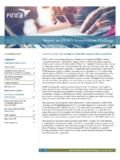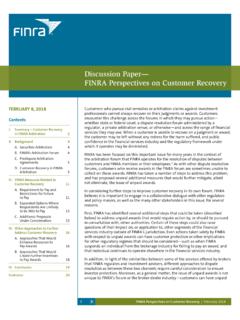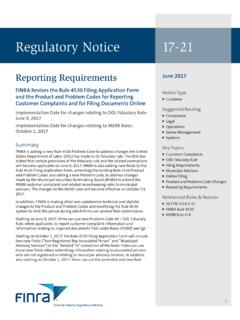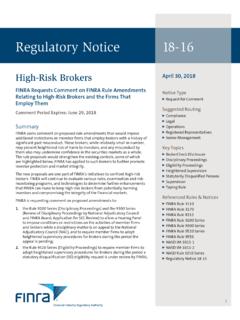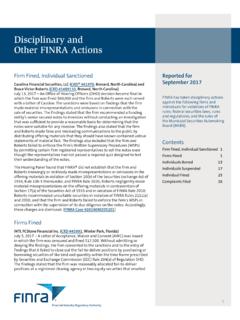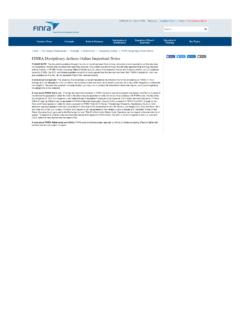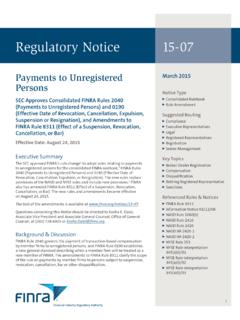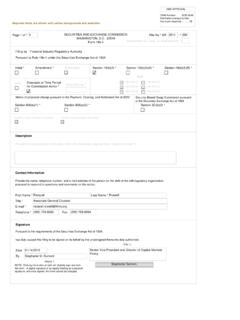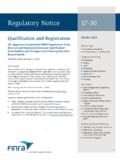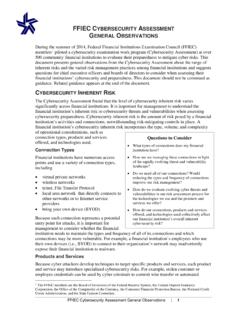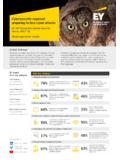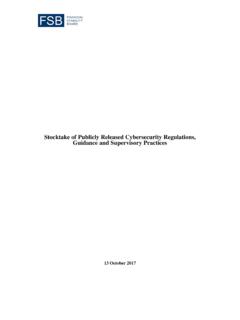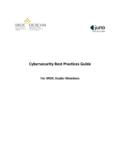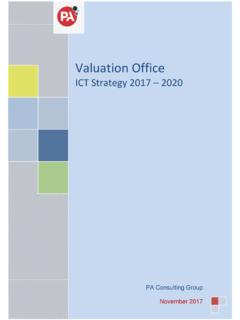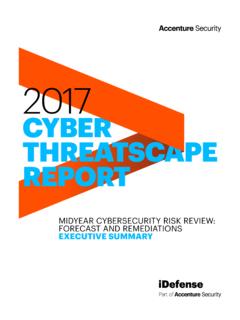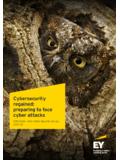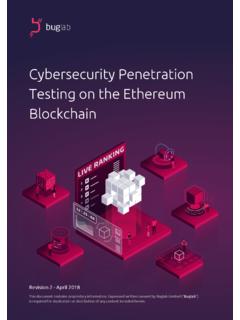Transcription of Report on Cybersecurity Practices - finra.org
1 A Report FROM THE FINANCIAL INDUSTRY REGULATORY AUTHORITYR eport on Cybersecurity PracticesREPORT ON Cybersecurity Practices FEBRUARY 20151 ContentsExecutive Summary 1 Background 3 Governance and Risk Management for Cybersecurity 6 Cybersecurity Risk Assessment 12 Technical Controls 16 Incident Response Planning 23 Vendor Management 26 Staff Training 31 Cyber Intelligence and Information Sharing 34 Cyber Insurance 37 Conclusion 38 Appendix I Summary of Principles and Effective Practices 39 Appendix II The NIST Framework 42 Appendix III Encryption Considerations 45 Endnotes 46 FEBRUARY 2015 Executive SummaryLike many organizations in the financial services and other sectors, broker-dealers (firms) are the target of cyberattacks. The frequency and sophistication of these attacks is increasing and individual broker-dealers, and the industry as a whole, must make responding to these threats a high priority. This Report is intended to assist firms in that effort.
2 Based on finra s 2014 targeted examination of firms and other related initiatives, the Report presents finra s latest work in this critical area. Given the rapidly evolving nature and pervasiveness of cyberattacks, it is unlikely to be our last. A variety of factors are driving firms exposure to Cybersecurity threats. The interplay between advances in technology, changes in firms business models, and changes in how firms and their customers use technology create vulnerabilities in firms information technology systems. For example, firms Web-based activities can create opportunities for attackers to disrupt or gain access to firm and customer information. Similarly, employees and customers are using mobile devices to access information at broker-dealers that create a variety of new avenues for landscape of threat actors includes cybercriminals whose objective may be to steal money or information for commercial gain, nation states that may acquire information to advance national objectives, and hacktivists whose objectives may be to disrupt and embarrass an entity.
3 Attackers, and the tools available to them, are increasingly sophisticated. Insiders, too, can pose significant Report presents an approach to Cybersecurity grounded in risk management to address these threats. It identifies principles and effective Practices for firms to consider, while recognizing that there is no one-size-fits-all approach to points in the Report include:00A sound governance framework with strong leadership is essential. Numerous firms made the point that board- and senior-level engagement on Cybersecurity issues is critical to the success of firms Cybersecurity assessments serve as foundational tools for firms to understand the Cybersecurity risks they face across the range of the firm s activities and assets no matter the firm s size or business model. Report ON Cybersecurity Practices FEBRUARY 2015200 Technical controls, a central component in a firm s Cybersecurity program, are highly contingent on firms individual situations. Because the number of potential control measures is large and situation dependent, finra discusses only a few representative controls here.
4 Nonetheless, at a more general level, a defense-in-depth strategy can provide an effective approach to conceptualize control implementation. 00 Firms should develop, implement and test incident response plans. Key elements of such plans include containment and mitigation, eradication and recovery, investigation, notification and making customers typically use vendors for services that provide the vendor with access to sensitive firm or client information or access to firm systems. Firms should manage Cybersecurity risk exposures that arise from these relationships by exercising strong due diligence across the lifecycle of their vendor well-trained staff is an important defense against cyberattacks. Even well-intentioned staff can become inadvertent vectors for successful cyberattacks through, for example, the unintentional downloading of malware. Effective training helps reduce the likelihood that such attacks will be successful. 00 Firms should take advantage of intelligence-sharing opportunities to protect themselves from cyber threats.
5 finra believes there are significant opportunities for broker-dealers to engage in collaborative self defense through such sharing. finra expects firms to consider the principles and effective Practices presented in this Report as they develop or enhance their Cybersecurity programs. finra will assess the adequacy of firms Cybersecurity programs in light of the risks they Report is not intended to express any legal position, and does not create any new legal requirements or change any existing regulatory obligations. Throughout the Report , we identify Cybersecurity Practices that we believe firms should consider and tailor to their business model as they strengthen their Cybersecurity InformationInquiries regarding the Report may be directed to Daniel M. Sibears, Executive Vice President, Regulatory Operations/Shared Services, at (202) 728 6911; John Brady, Vice President, Cybersecurity , at (240) 386 5524; or Steven Polansky, Senior Director, Regulatory Programs/ Shared Services, at (202) 728 ON Cybersecurity Practices FEBRUARY 20153 BackgroundIn 2014, finra launched a targeted examination (sweep) to explore Cybersecurity .
6 finra had four primary objectives: 00to better understand the types of threats that firms face;00to increase our understanding of firms risk appetite, exposure and major areas of vulnerabilities in their information technology systems; 00to better understand firms approaches to managing these threats; and 00to share observations and findings with firms. finra sent its information request to a cross section of firms, including large investment banks, clearing firms, online brokerages, high-frequency traders and independent has also been a regular theme in our Regulatory and Examination Priorities Letter since 2007. In addition, in June 2011, finra conducted a survey of 224 firms (survey) to better understand industry information technology and Cybersecurity Practices and issues that may impact investor protection or market integrity. In 2010 and 2011, finra also conducted on-site reviews of firms of varying sizes and business models to increase our awareness of how firms control critical information technology and cyber financial sector regulators are, of course, also focusing on Cybersecurity , and finra continues to work with its regulatory counterparts on issues of mutual concern.
7 In developing the observations and Practices in this document, finra draws on a variety of sources, including the 2014 sweep, interviews with other organizations involved in Cybersecurity , previous finra work on Cybersecurity and publicly available information. This Report focuses on select topics that serve as a resource for firms developing or advancing their Cybersecurity programs: 00cybersecurity governance and risk management; 00cybersecurity risk assessment;00technical controls;00incident response planning;Each section of the Report highlights Principles and Effective Practices . (Appendix I summarizes these principles and effective Practices .) The Report does not purport to cover all Cybersecurity topics, nor does it provide exhaustive guidance on each Cybersecurity issue discussed herein. Instead, finra s objective is to focus firms on a risk management-based approach to Cybersecurity . This enables firms to tailor their program to their particular circumstances; as every firm in our sweep emphasized, there is no one-size-fits-all approach to Cybersecurity .
8 Many of the Practices discussed in this Report are geared to large firms with sophisticated management structures, but we believe small firms can benefit from this Report as well, and we will continue to pursue opportunities to assist their Cybersecurity efforts. Defining Cybersecurity Firms defined Cybersecurity in different ways. For purposes of this Report , finra takes a broad view and defines Cybersecurity as the protection of investor and firm information from compromise through the use in whole or in part of electronic digital media, ( , computers, mobile devices or Internet protocol-based telephony systems). Compromise refers to a loss of data confidentiality, integrity or management; 00staff training;00cyber intelligence and information sharing; and00cyber ON Cybersecurity Practices FEBRUARY 20154 Given this definition, not all issues we discuss in this Report are viewed by firms as within the scope of their Cybersecurity program. For example, some firms would address fraudulent wire transfers carried out through socially engineered phishing attacks through their anti-fraud, rather than their Cybersecurity programs.
9 Regardless of how firms categorize their Cybersecurity control measures, what is important to finra is that firms have appropriate risk management measures in place to address the Cybersecurity -related threats they LandscapeIn both the 2014 sweep and the 2011 survey, firms identified the following top three threats: 00hackers penetrating firm systems; 00insiders compromising firm or client data; and 00operational risks. Table 1 provides a more detailed breakdown of firms responses regarding threats they 1: Summary of Firm Responses on Top Three Threats2014 Sweep Results(% of respondents ranking threat as 1st, 2nd or 3rd)2011 Survey Results(% of respondents ranking threat as 1st, 2nd or 3rd)1st2nd3rd1st2nd3rdCyber risk of hackers penetrating systems for the purpose of account manipulation, defacement or data destruction, for example332811383319 Operational risk associated with environmental problems ( , power failures) or natural disasters ( , earthquakes, hurricanes)
10 221717311629 Insider risk of employees or other authorized users abusing their access by harvesting sensitive information or otherwise manipulating the system or data undetected221133243522 Insider risk of employees or other authorized users placing time bombs or other destructive activities0110045 Cyber risk of non-nation states or terrorist groups penetrating systems, for example, for the purpose of wreaking havoc066045 Cyber risk of nation states penetrating systems, for example, for the purpose of espionage066025 Cyber risk of competitors penetrating systems, for example, for the purpose of corporate espionage000024 Report ON Cybersecurity Practices FEBRUARY 20155 Not surprisingly, the ranking of threats varies by firm and by business model. For example, online brokerage firms and retail brokerages are more likely to rank the risk of hackers as their top priority risk. Firms that engage in algorithmic trading were more likely to rank insider risks more highly. Large investment banks or broker-dealers typically ranked risks from nation states or hacktivist groups more highly than other need to understand the types of threats they face, their assets most likely to be targeted for attack and the likely sources of these threats.
